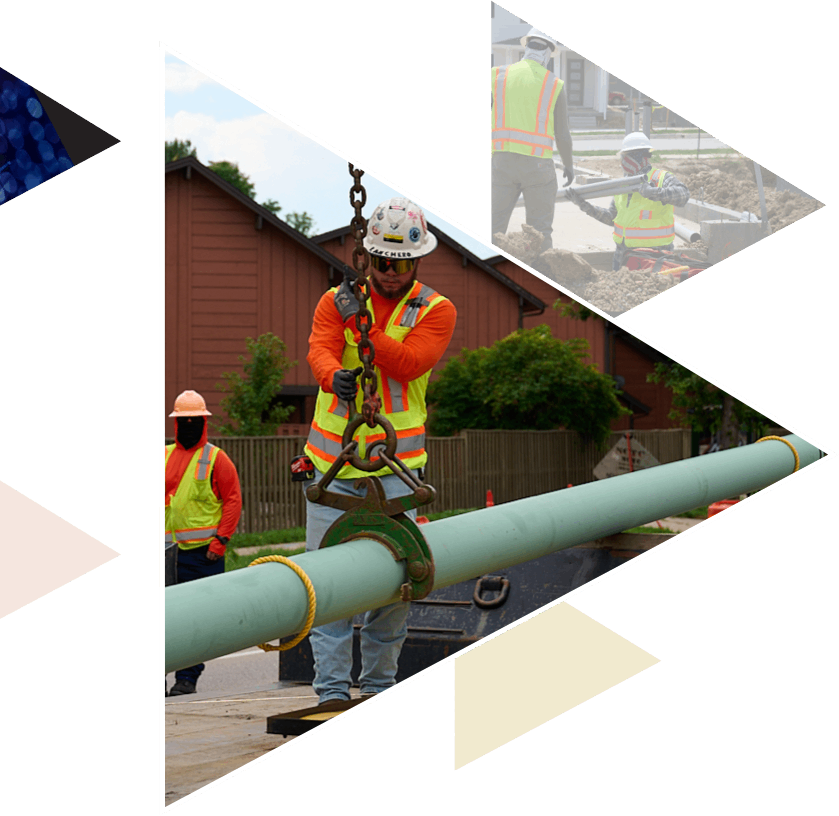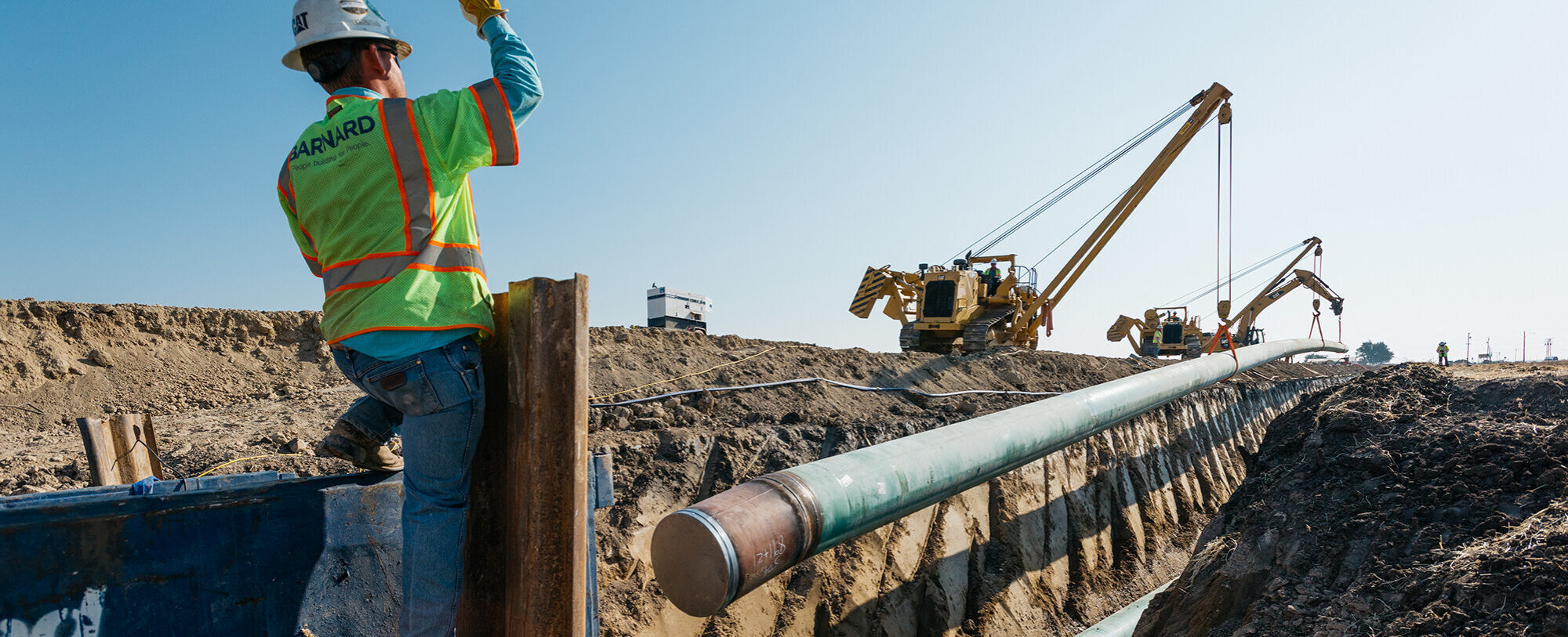How Safety Standards Shape Reliable Pipeline Construction Services
Wiki Article
Checking Out the current Advancements in Pipeline Construction Providers for Modern Projects
The Pipeline Construction sector is going through considerable changes. Innovations such as smart products and robotics are improving traditional techniques. These innovations assure to boost performance and safety and security. Furthermore, AI innovations are improving job management capacities. As these components converge, they question regarding their lasting influence on sustainability and expense. Understanding these technologies is crucial for stakeholders looking to browse this evolving landscape. What ramifications do they hold for future tasks?The Increase of Smart Products in Pipeline Construction
As the demand for much more sustainable and efficient Pipeline systems raises, the assimilation of smart products has actually emerged as a transformative option in Pipeline Construction. These innovative materials possess unique homes that improve the performance and durability of pipes. Self-healing polymers can automatically repair minor leakages, significantly lowering maintenance prices and downtime. Furthermore, materials installed with sensing units can keep an eye on structural stability and ecological conditions, permitting real-time data collection and analysis.Moreover, clever materials are corrosion-resistant and usually light-weight, which not only streamlines installation however likewise prolongs the life expectancy of the systems. Their flexibility enables pipelines to endure extreme ecological conditions, promoting security and dependability. As markets increasingly prioritize sustainability, the use of green clever products adds to minimized ecological impact. Generally, the increase of wise materials marks a remarkable shift in Pipeline Construction, paving the way for ingenious remedies to meet contemporary framework requirements.
Advancements in Robotics for Installation and Upkeep
The combination of wise materials in Pipeline Construction is complemented by innovations in robotics, which are revolutionizing installation and maintenance procedures. Robot modern technologies, such as automated welding systems and drones, boost effectiveness and accuracy, reducing human mistake and lessening security risks. These robotics can operate in challenging atmospheres, making certain that installations are performed in unsafe or remote locations without putting workers in jeopardy.Robotic inspection devices outfitted with sophisticated sensing units offer real-time data on Pipeline integrity, permitting for proactive upkeep. They can discover leaks or structural weaknesses, making it possible for prompt treatments that extend the life expectancy of Pipeline systems. The use of robotics not just increases the Construction timeline but likewise enhances source allotment, leading to cost financial savings. As these technologies proceed to develop, they are established to play a vital role in forming the future of Pipeline Construction, ensuring dependability and sustainability in framework advancement.
AI-Driven Task Management Equipment Transforming Process
AI-driven task monitoring tools are improving operations in Pipeline Construction by enhancing decision-making processes with improved access to real-time data analytics. These devices enable teams to react swiftly to project developments, consequently raising efficiency. Streamlined communication channels foster cooperation amongst stakeholders, better maximizing task results.Improved Decision-Making Processes

Real-Time Information Analytics
Harnessing real-time information analytics, contemporary task monitoring tools transform workflow in Pipeline Construction. These advanced tools take advantage of synthetic intelligence to offer immediate understandings right into job efficiency, resource allowance, and possible threats. By continually checking vital efficiency indicators, teams can swiftly adjust to changing problems, optimizing labor and products use. The assimilation of real-time data enables more informed decision-making, minimizing delays and minimizing prices. Additionally, predictive analytics can recognize patterns and forecast obstacles prior to they rise, improving overall task performance. Therefore, Pipeline Construction business that adopt these AI-driven devices can enhance task timelines and results, guaranteeing they stay competitive in an increasingly complex sector landscape. This advancement marks a significant change toward data-centric monitoring methods.Streamlined Interaction Channels
Effective interaction is extremely important in Pipeline Construction, where various stakeholders need to work together seamlessly to ensure project success. The introduction of AI-driven job management devices has revolutionized interaction channels within the sector. These tools promote real-time information sharing, enabling groups to gain access to updates, share records, and track progression effectively. By automating regular tasks and supplying a central system for communication, these innovations get rid of misconceptions and decrease hold-ups. Enhanced exposure right into job timelines and source appropriation promotes liability among staff member. Additionally, AI analytics can recognize potential interaction voids, ensuring aggressive problem-solving. Ultimately, streamlined interaction networks not only improve process yet additionally raise general task efficiency, allowing Pipeline Construction companies to fulfill contemporary needs successfully.Boosted Safety And Security Methods Through Innovation Assimilation
The assimilation of technology in Pipeline Construction has actually brought about enhanced safety protocols. Real-time tracking systems, wearable security gadgets, and automated danger evaluations are currently necessary parts in decreasing threats on work sites. These developments not only improve worker safety but additionally simplify conformity with sector regulations.Real-Time Monitoring Systems
Just how can real-time surveillance systems change Pipeline Construction safety and security methods? By incorporating sophisticated innovation, these systems supply constant monitoring of Construction activities, ensuring immediate detection of possible dangers. Cams and sensors can keep track of ecological problems, devices performance, and workforce activities, providing critical data in real time. This aggressive strategy enables project managers to determine risks prior to they intensify, significantly boosting safety and security actions on-site. In addition, real-time surveillance assists in conformity with regulative requirements, ensuring that safety and security standards are fulfilled regularly. The capacity to evaluate information instantly sustains enlightened decision-making, making it possible for timely treatments. As a result, Pipeline Construction jobs can operate more effectively while safeguarding the wellness of workers and minimizing mishaps, therefore reinventing the sector's security landscape.Wearable Safety Gadgets
Often, wearable safety devices are being integrated into Pipeline Construction to enhance safety and security methods. These ingenious devices, including smart helmets, vests, and wristbands, are created to keep track of worker health and wellness and ecological conditions in real-time. Geared up with sensors, these tools can discover hazards such as harmful gas direct exposure, too much heat, or high noise levels, supplying instant informs to supervisors and employees. Additionally, wearable innovation usually consists of general practitioner monitoring attributes, allowing for reliable area monitoring of employees on-site. This capacity not just help in fast action during emergency situations however also enhances general task administration. By prioritizing employee security with innovation combination, Pipeline Construction business are making substantial strides in minimizing mishaps and advertising a culture of security within the industry.
Automated Threat Evaluations
While traditional danger analyses often rely upon manual analyses, the integration of computerized threat evaluation innovations is changing safety and security methods in Pipeline Construction. These sophisticated systems take advantage of information analytics, expert system, and machine knowing to identify potential threats much more properly and successfully. By constantly keeping an eye on environmental problems, devices status, and employee behavior, automated evaluations give real-time insights that boost decision-making. This aggressive strategy reduces the possibility of mishaps and boosts compliance with security regulations. Furthermore, automated risk assessments can be updated instantly, making certain that all Find Out More stakeholders have accessibility to the most recent information. Because of this, Pipeline Construction projects profit from a much safer workplace, minimizing disturbances and cultivating a society of security through technology integration.Lasting Practices in Pipeline Construction
As the need for power facilities climbs, the Pipeline Construction market increasingly prioritizes sustainable techniques that reduce ecological effect. Business are embracing environmentally friendly products and sophisticated Construction techniques to decrease their carbon impact. The usage of trenchless modern technology permits for Pipeline setup with marginal disruption to the surrounding atmosphere, decreasing and protecting natural habitats dirt erosion.
Protecting In addition, the implementation of renewable resource resources, such as solar or wind, to power Construction tasks is gaining grip. This change not just lowers dependence on fossil gas but likewise improves the general sustainability of Pipeline jobs. Efficient waste management techniques, consisting of reusing and recycling materials, are coming to be criterion in the market.
Real-Time Tracking and Anticipating Maintenance Solutions
The shift towards sustainable practices in Pipeline Construction has visit this web-site actually led the way for the assimilation of real-time surveillance and anticipating upkeep remedies. These modern technologies take advantage of progressed information and sensors analytics to constantly evaluate Pipeline stability and functional efficiency. By collecting information in actual time, operators can identify abnormalities such as leaks or pressure declines prior to they rise into major concerns. This proactive approach not only decreases ecological risks yet likewise reduces downtime and maintenance costs.Anticipating maintenance employs formulas to anticipate potential failures based upon historic data and current efficiency metrics. This enables timely treatments, enhancing maintenance timetables and resource allocation. Generally, real-time tracking and predictive upkeep solutions stand for a substantial advancement in Pipeline Construction, improving safety and dependability while sustaining sustainability objectives. As industries proceed to accept these innovations, the functional landscape of Pipeline management is readied to evolve dramatically, guaranteeing long-term feasibility and efficiency.
The Duty of Drones in Checking and Examination
check Drones have arised as transformative devices in the checking and examination of pipelines, using enhanced performance and precision. Their capacity to capture high-resolution pictures and video clips from different angles permits comprehensive evaluations of Pipeline stability without taking the chance of human safety and security. Outfitted with sophisticated sensors and thermal imaging abilities, drones can detect leaks, deterioration, and architectural abnormalities that may not be visible to the nude eye.The implementation of drones considerably lowers evaluation time, enabling quicker decision-making for maintenance and repair work. This effectiveness translates to set you back financial savings and very little interruption to bordering atmospheres. Drones can also access hard-to-reach areas, such as raised structures or tough terrains, even more broadening the extent of inspections.
As the Pipeline industry proceeds to welcome technical developments, the integration of drones into evaluating and inspection procedures is anticipated to expand, establishing brand-new requirements for operational excellence and safety in Pipeline Construction services.
Regularly Asked Concerns
What Are the Expenses Associated With Modern Pipeline Construction Innovations?
The expenses connected with contemporary Pipeline Construction innovations frequently consist of innovative products, specialized labor, and advanced technology. These variables contribute to higher first financial investment, however can result in long-lasting cost savings through boosted effectiveness and reduced maintenance needs.Just How Do Regulative Changes Effect Pipeline Construction Technologies?
Regulatory modifications significantly influence Pipeline Construction innovations by demanding the adoption of much safer, much more reliable techniques. Conformity needs usually drive advancement, leading to improvements in materials, layout, and Construction methods that enhance general task sustainability and safety.What Abilities Are Needed for Jobs in Advanced Pipeline Construction?

Careers in sophisticated Pipeline Construction need proficiency in engineering concepts, task monitoring, safety and security procedures, and ecological laws. In addition, skills in modern technology combination, synergy, and problem-solving are vital for going across the intricacies of modern-day framework projects.
How Can Companies Ensure Conformity With Environmental Criteria?
To ensure compliance with environmental requirements, companies ought to carry out strenuous training programs, perform normal audits, and adopt best practices in sustainability. Engaging with stakeholders and keeping track of regulatory modifications better reinforces their dedication to ecological stewardship.
What Are the Trick Difficulties Encountering Pipeline Construction Today?
The essential difficulties dealing with Pipeline Construction today include governing compliance, environmental problems, fluctuating material expenses, labor scarcities, and the need for innovative technology integration (Pipeline Construction Services). These aspects make complex task timelines and overall effectiveness in the marketAs the need for a lot more efficient and lasting Pipeline systems increases, the combination of wise products has actually emerged as a transformative service in Pipeline Construction. AI-driven job administration devices are improving workflows in Pipeline Construction by improving decision-making procedures via improved access to real-time data analytics. While job administration in Pipeline Construction has actually commonly relied on hand-operated procedures, the assimilation of sophisticated devices substantially improves decision-making capacities. Harnessing real-time information analytics, modern-day task monitoring devices reinvent operations in Pipeline Construction. Jobs in sophisticated Pipeline Construction need competence in engineering principles, project management, safety protocols, and environmental regulations.
Report this wiki page